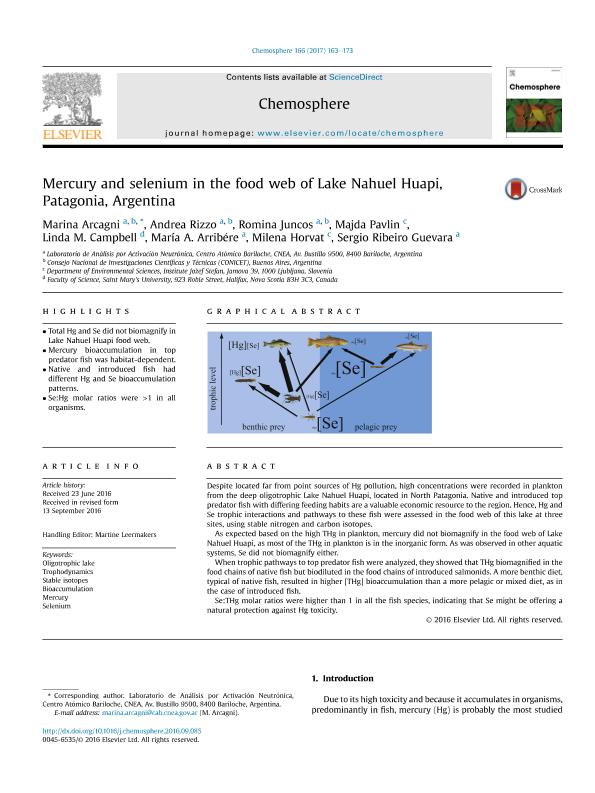Artículo
Mercury and selenium in the food web of Lake Nahuel Huapi, Patagonia, Argentina
Arcagni, Marina ; Rizzo, Andrea Paula
; Rizzo, Andrea Paula ; Juncos, Romina
; Juncos, Romina ; Pavlin, Majda; Campbell, Linda M; Arribere, Maria Angelica; Horvat, Milena; Ribeiro Guevara, Sergio
; Pavlin, Majda; Campbell, Linda M; Arribere, Maria Angelica; Horvat, Milena; Ribeiro Guevara, Sergio
 ; Rizzo, Andrea Paula
; Rizzo, Andrea Paula ; Juncos, Romina
; Juncos, Romina ; Pavlin, Majda; Campbell, Linda M; Arribere, Maria Angelica; Horvat, Milena; Ribeiro Guevara, Sergio
; Pavlin, Majda; Campbell, Linda M; Arribere, Maria Angelica; Horvat, Milena; Ribeiro Guevara, Sergio
Fecha de publicación:
01/2017
Editorial:
Pergamon-Elsevier Science Ltd
Revista:
Chemosphere
ISSN:
0045-6535
Idioma:
Inglés
Tipo de recurso:
Artículo publicado
Clasificación temática:
Resumen
Despite located far from point sources of Hg pollution, high concentrations were recorded in plankton from the deep oligotrophic Lake Nahuel Huapi, located in North Patagonia. Native and introduced top predator fish with differing feeding habits are a valuable economic resource to the region. Hence, Hg and Se trophic interactions and pathways to these fish were assessed in the food web of this lake at three sites, using stable nitrogen and carbon isotopes. As expected based on the high THg in plankton, mercury did not biomagnify in the food web of Lake Nahuel Huapi, as most of the THg in plankton is in the inorganic form. As was observed in other aquatic systems, Se did not biomagnify either. When trophic pathways to top predator fish were analyzed, they showed that THg biomagnified in the food chains of native fish but biodiluted in the food chains of introduced salmonids. A more benthic diet, typical of native fish, resulted in higher [THg] bioaccumulation than a more pelagic or mixed diet, as in the case of introduced fish. Se:THg molar ratios were higher than 1 in all the fish species, indicating that Se might be offering a natural protection against Hg toxicity.
Archivos asociados
Licencia
Identificadores
Colecciones
Articulos(CCT - PATAGONIA NORTE)
Articulos de CTRO.CIENTIFICO TECNOL.CONICET - PATAGONIA NORTE
Articulos de CTRO.CIENTIFICO TECNOL.CONICET - PATAGONIA NORTE
Citación
Arcagni, Marina; Rizzo, Andrea Paula; Juncos, Romina; Pavlin, Majda; Campbell, Linda M; et al.; Mercury and selenium in the food web of Lake Nahuel Huapi, Patagonia, Argentina; Pergamon-Elsevier Science Ltd; Chemosphere; 166; 1-2017; 163-173
Compartir
Altmétricas



